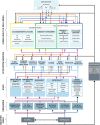A Conceptual Model to Assess Stress-Associated Health Effects of Multiple Ecosystem Services Degraded by Disaster Events in the Gulf of Mexico and Elsewhere
- PMID: 30596189
- PMCID: PMC6309401
- DOI: 10.1002/2016GH000038
A Conceptual Model to Assess Stress-Associated Health Effects of Multiple Ecosystem Services Degraded by Disaster Events in the Gulf of Mexico and Elsewhere
Abstract
Few conceptual frameworks attempt to connect disaster-associated environmental injuries to impacts on ecosystem services (the benefits humans derive from nature) and thence to both psychological and physiological human health effects. To our knowledge, this study is one of the first, if not the first, to develop a detailed conceptual model of how degraded ecosystem services affect cumulative stress impacts on the health of individual humans and communities. Our comprehensive Disaster-Pressure State-Ecosystem Services-Response-Health (DPSERH) model demonstrates that oil spills, hurricanes, and other disasters can change key ecosystem components resulting in reductions in individual and multiple ecosystem services that support people's livelihoods, health, and way of life. Further, the model elucidates how damage to ecosystem services produces acute, chronic, and cumulative stress in humans which increases risk of adverse psychological and physiological health outcomes. While developed and initially applied within the context of the Gulf of Mexico, it should work equally well in other geographies and for many disasters that cause impairment of ecosystem services. Use of this new tool will improve planning for responses to future disasters and help society more fully account for the costs and benefits of potential management responses. The model also can be used to help direct investments in improving response capabilities of the public health community, biomedical researchers, and environmental scientists. Finally, the model illustrates why the broad range of potential human health effects of disasters should receive equal attention to that accorded environmental damages in assessing restoration and recovery costs and time frames.
Keywords: 0400 Biogeosciences; 0439 (Ecosystems, structure and dynamics); 4300 Natural Hazards: 4304 (Natural hazards, oceanic); 4322 (Natural hazards, health impacts); 4335 (Natural hazards, disaster management); Conceptual model; Ecosystem services; Environmental disasters; Gulf of Mexico; Human health; Stress and health problems.
Conflict of interest statement
The authors declare no conflicts of interest relevant to this study.
Figures




Similar articles
-
The Minderoo-Monaco Commission on Plastics and Human Health.Ann Glob Health. 2023 Mar 21;89(1):23. doi: 10.5334/aogh.4056. eCollection 2023. Ann Glob Health. 2023. PMID: 36969097 Free PMC article. Review.
-
Conceptual Framework for Assessing Ecosystem Health.Integr Environ Assess Manag. 2019 Jul;15(4):544-564. doi: 10.1002/ieam.4152. Epub 2019 Jul 25. Integr Environ Assess Manag. 2019. PMID: 30908815 Free PMC article.
-
Beyond the black stump: rapid reviews of health research issues affecting regional, rural and remote Australia.Med J Aust. 2020 Dec;213 Suppl 11:S3-S32.e1. doi: 10.5694/mja2.50881. Med J Aust. 2020. PMID: 33314144
-
Framework for a Community Health Observing System for the Gulf of Mexico Region: Preparing for Future Disasters.Front Public Health. 2020 Oct 15;8:578463. doi: 10.3389/fpubh.2020.578463. eCollection 2020. Front Public Health. 2020. PMID: 33178663 Free PMC article.
-
Enhancing Disaster Resilience by Reducing Stress-Associated Health Impacts.Front Public Health. 2018 Dec 21;6:373. doi: 10.3389/fpubh.2018.00373. eCollection 2018. Front Public Health. 2018. PMID: 30627528 Free PMC article. Review.
Cited by
-
Earth System's Gatekeeping of "One Health" Approach to Manage Climate-Sensitive Infectious Diseases.Geohealth. 2022 Apr 1;6(4):e2021GH000543. doi: 10.1029/2021GH000543. eCollection 2022 Apr. Geohealth. 2022. PMID: 35465270 Free PMC article.
-
Oil Spills and Human Health: Contributions of the Gulf of Mexico Research Initiative.Geohealth. 2019 Dec 11;3(12):391-406. doi: 10.1029/2019GH000217. eCollection 2019 Dec. Geohealth. 2019. PMID: 32159026 Free PMC article. Review.
-
Environmental health risk relationships, responsibility, and sources of information among Vietnamese Americans in coastal Mississippi.Health Risk Soc. 2020;22(5-6):362-376. doi: 10.1080/13698575.2020.1840528. Epub 2020 Oct 27. Health Risk Soc. 2020. PMID: 33762882 Free PMC article.
-
Developing a Conceptual Framework for Environmental Health Tracking in Victoria, Australia.Int J Environ Res Public Health. 2019 May 17;16(10):1748. doi: 10.3390/ijerph16101748. Int J Environ Res Public Health. 2019. PMID: 31108844 Free PMC article.
-
Linking coastal environmental and health observations for human wellbeing.Front Public Health. 2023 Sep 14;11:1202118. doi: 10.3389/fpubh.2023.1202118. eCollection 2023. Front Public Health. 2023. PMID: 37780424 Free PMC article.
References
-
- Abramson, D. M. , Grattan L. M., Mayer B., Colten C. E., Arosemena F. A., Bedimo‐Rung A., and Lichtveld M. (2015), The resilience activation framework: A conceptual model of how access to social resources promotes adaptation and rapid recovery in post‐disaster settings, J. Behav. Health Serv. Res., 42(1), 42–57, doi:10.1007/s114114-014-9420-2. - DOI - PMC - PubMed
-
- Adeola, F. O. , and Picou J. S. (2012), Race, social capital, and the health impacts of Katrina: Evidence from the Louisiana and Mississippi Gulf Coast, Res. Hum. Ecol., 19(1), 10–24.
-
- Adeola, F. O. , and Picou J. S. (2014), Social capital and the mental health impacts of Hurricane Katrina: Assessing long‐term patterns of psychosocial distress, IJMED, 32(1), 121–156.
Grants and funding
LinkOut - more resources
Full Text Sources
